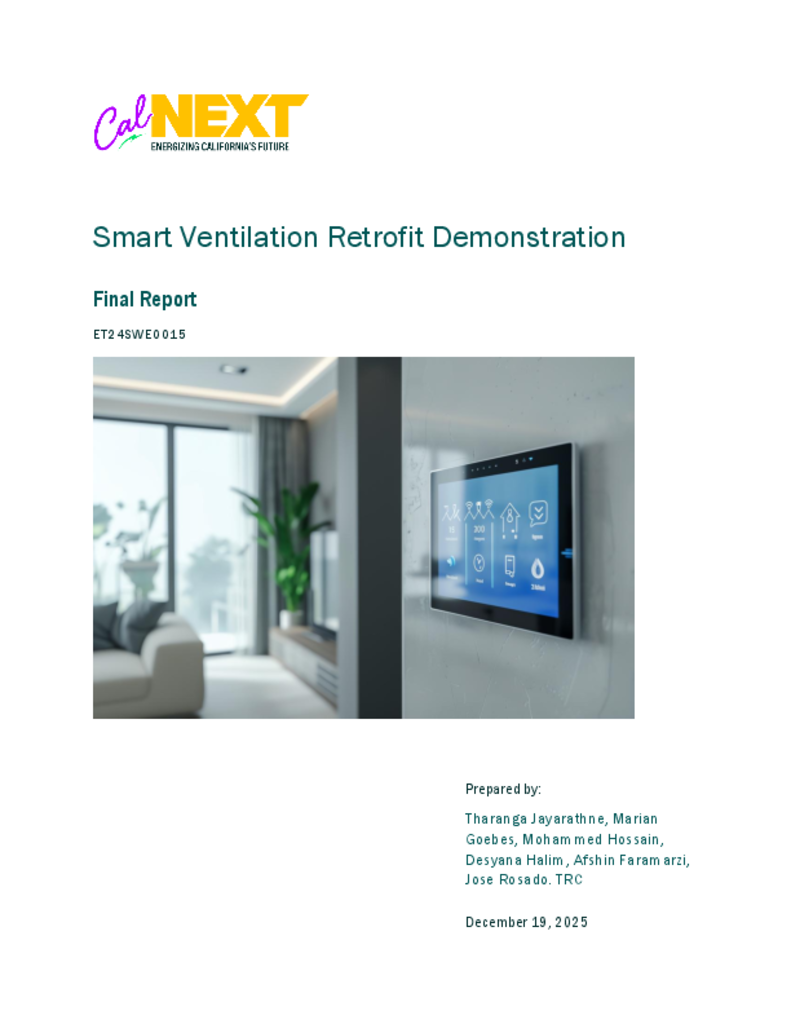ET24SWE0015 - Smart Ventilation Retrofit Demonstration Project
Mechanical ventilation is becoming more prevalent due to Indoor Air quality (IAQ) concerns, particularly as construction trends move towards tighter envelopes to increase efficiency. Yet there is a tension between providing ventilation to ensure good IAQ and reducing the energy and demand impacts of this ventilation.
This project investigates “smart ventilation” systems that have sensors to track pollutants and automate ventilation systems to address IAQ. These systems reduce energy use by only operating ventilation equipment when needed. Smart ventilation systems include apps that provide the user with an app-based interface, tracking and logging IAQ along with run time presented on an easy-to-understand graphic display. Customers can use this feedback to improve the air quality in their home. In addition, because many residents forget to turn on smart ventilation systems, automated demand-based controls activate systems when needed rather than relying on activation by the user. Poor ventilation can increase concentrations of pollutants such as NO2 and PM2.5, and both pollutants can contribute to asthma[1]. High humidity combined with poor ventilation can drive increased pollutant levels, increasing the risk of asthma symptoms[2]. The importance of ventilation is even greater for low-income households, as asthma rates can be higher among low-income residents[3]. In addition, ventilation is important to reduce pollution from smoking and second-hand smoke, and smoking rates among adults receiving federal housing assistance are almost twice the rate of the general population[4]. Smart ventilation is a promising, emerging technology that can provide good IAQ with minimal energy and demand impacts.
Our general approach to the study involves these tactics:
- Retrofit multifamily dwelling units with smart ventilation products that sense pollutant concentrations and automate ventilation systems accordingly.
- Conduct energy metering to measure ventilation energy use and demand impacts.
- Collect IAQ data to measure key pollutant levels.
- Report IAQ trends along with energy usage trends and feedback from residents through an electronic survey
The overall objective of the project is to demonstrate that improved IAQ in households can be achieved through a “smart ventilation” approach while also minimizing ventilation energy use.
[1] The Links Between Air Pollution and Childhood Asthma | US EPA
[2] INDOOR DAMPNESS AND ASTHMA - Clearing the Air - NCBI Bookshelf (nih.gov)
[3] American Lung Association. 2018. Current Asthma Demographics. https://www.lung.org/research/trends-in-lung-disease/asthma-trends-brief/current-demographics.
[4] Hernández, Diana, et al. 2019. "Insights on the social contract of smoke-free housing policy in affordable housing settings." https://www.ncbi.nlm.nih.gov/pmc/articles/PMC7146084/
As residential construction moves toward tighter building envelopes to enhance energy efficiency, maintaining indoor air quality (IAQ) has become a critical challenge. California’s Title 24 Building Energy Efficiency Standards mandate continuous or scheduled outdoor air (OA) ventilation in residential new construction but does not provide a path to dynamically vary ventilation based on pollutant levels. This project explored the potential of smart ventilation systems that activate ventilation based on real-time IAQ measurements, aiming to improve energy efficiency while maintaining acceptable IAQ.
The study included field demonstrations in 17 apartments across two multi-family sites, energy simulation modeling, and resident surveys. The smart ventilation system operated the OA fan intermittently and was able to maintain acceptable IAQ in the majority of the apartments. But for most apartments, the OA fan status did not need to change much before vs. after the smart ventilation system. At the first site where the OA fan was always off before, the smart ventilation system only needed to operate the OA fan 17 to 34% of the time for acceptable IAQ. At the second site, where the OA fan was always on before, the smart ventilation system needed to operate the OA fan continuously or near continuously for acceptable IAQ except in one apartment (75% operation).
Energy modeling showed significant savings potential for smart ventilation compared to continuously operating the OA fan, particularly in climates with high heating or cooling demands, with annual savings ranging from 450 to 1,400 kilowatt-hours per dwelling unit.
User feedback showed satisfaction from most participants but highlighted the need for improved system interfaces and user education. The findings emphasized the importance of addressing underlying ventilation system issues, including ensuring adequate ventilation airflow, and tailoring systems to specific climate conditions.
This research demonstrated the feasibility and energy-saving potential of pollutant-based smart ventilation systems, supporting California’s energy and IAQ goals. Future efforts should focus on system reliability, enhancing user understanding, and then developing programmatic offerings, and integrating smart ventilation pathways into residential energy codes.

